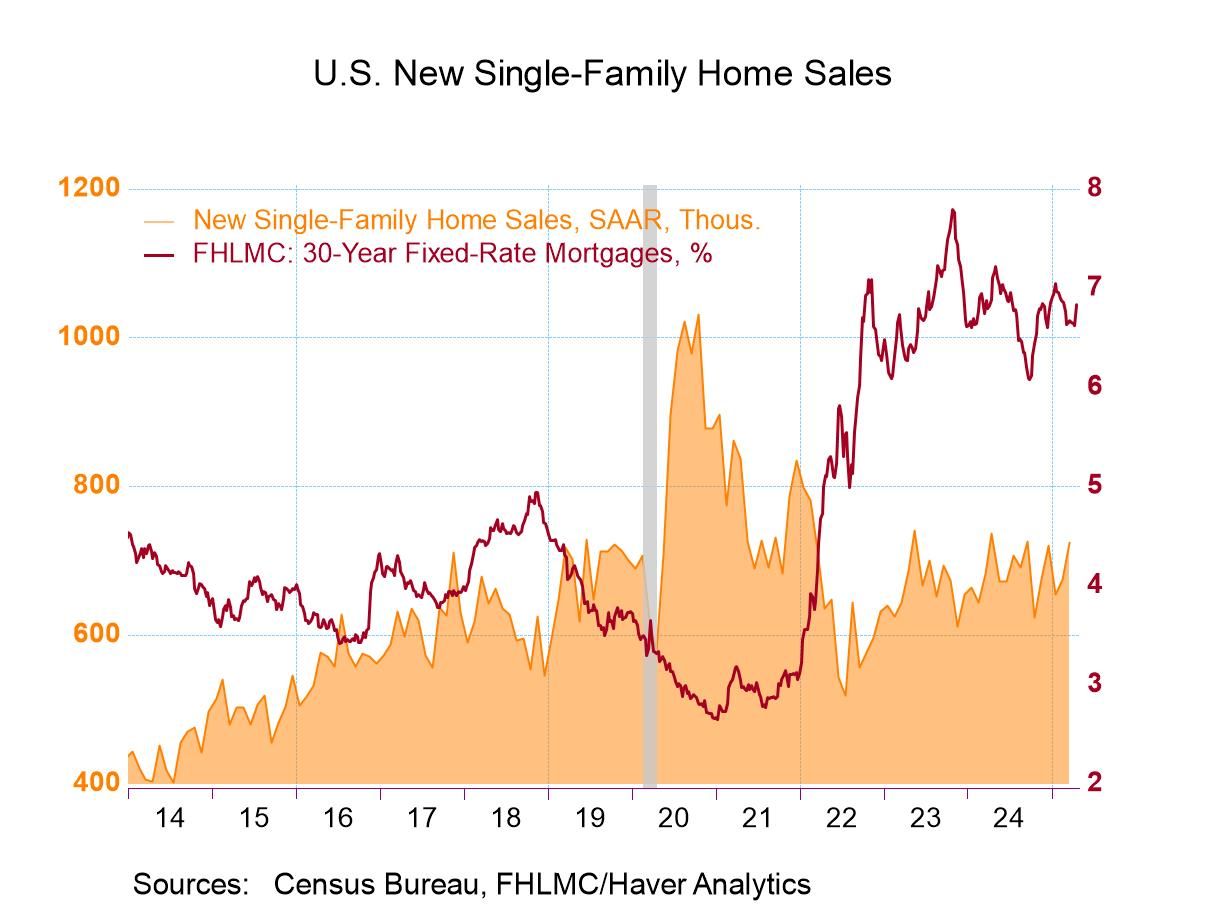 Global| Jun 26 2014
Global| Jun 26 2014U.S. Consumers Cautiously Raise Spending; Price Inflation Ramps Up
by:Tom Moeller
|in:Economy in Brief
Summary
Personal consumption expenditures rose 0.2% during May (3.7% y/y) following no change in April, revised from the 0.1% dip reported last month. A 0.4% rise had been expected in the Action Economic Forecast Survey. When adjusted for [...]
Personal consumption expenditures rose 0.2% during May (3.7% y/y) following no change in April, revised from the 0.1% dip reported last month. A 0.4% rise had been expected in the Action Economic Forecast Survey. When adjusted for price inflation, however, spending slipped 0.1% (+1.9% y/y), the second consecutive down month. Nominal spending was restrained by a 0.4% decline (+3.5% y/y) in housing & utilities purchases. Health care outlays rose a modest 0.2% for a second month. The y/y rise of 2.9% in health care outlays was off the 3.8% pace of last year and the roughly 4.5% gains of the prior two years. In constant dollars, health care spending was unchanged for the second consecutive month and was reduced versus the 1.3% year-to-date rise. Nominal spending on durable goods increased 0.7% (3.9% y/y) and recovered most of a 0.9% April decline. A 2.3% rebound (7.2% y/y) in motor vehicle purchases led the increase. Spend on furnishings and appliances rose 0.4%, though the annual gain of 2.9% was lower than the 4%-6% pace of the prior three years. Nondurable goods spending increased 0.2% (3.6% y/y), half the prior month's increase. A 0.6% decline (+1.0% y/y) in clothing purchases and a 0.3% drop (+1.6% y/y) in spending on food & beverages held back the increase.
Price inflation continued to firm last month as indicated by a 1.8% y/y rise in the PCE chain price index. That compares to a 0.8% y/y low in February and a 1.1% rise for all of last year. The latest was the third consecutive 0.2% monthly increase (1.8% y/y) in the price index. Faster growth in core prices powered the overall index with a 1.5% y/y rise. That's versus a 1.1% y/y low in February and 1.2% during all of last year. The May gain was the third consecutive 0.2% increase and followed eight consecutive months of 0.1% rise. Energy prices increased 5.8% y/y while food costs gained 2.1% y/y. Services prices surged 2.2% y/y, the quickest pace since mid-2012. Most categories strengthened but none more than housing & utilities where the price index increased 3.0% y/y, double the 2001 low. Nondurable goods prices gained 2.4%, up from a 0.5% y/y decline just three months ago. The acceleration was wide-spread. Declines in durables goods prices have been fairly stable at a 2.1% rate.
Personal income increased 0.4% during May (3.5% y/y) after a 0.3% April rise. The gain was fueled by a 0.4% increase (3.8% y/y) in wages & salaries which followed a 0.3% gain. Rental incomes increased a firm 0.4% (5.6% y/y) for a second straight month while proprietors income rose 0.2% (2.3% y/y). Earnings from portfolio investments was improved as dividend income gained 1.2% (6.6% y/y), strong for the fourth straight month. Interest income increased a moderate 0.3% (1.9% y/y) for the second consecutive month. Transfer payments increased a firm 0.4% (3.9% y/y), although social security payments only ticked 0.1% higher (4.4% y/y). Disposable personal income gained 0.4% (3.7% y/y) for the second consecutive month. Adjusted for price inflation, take-home pay rose 0.2% (1.9% y/y) for a second consecutive month
The strength in income versus the moderate spending rise pulled the personal savings rate up to 4.8%, its highest level since August. The improvement occurred as savings rose 6.5% (4.0% y/y).
The personal income & consumption figures are available in Haver's USECON and USNA databases. The consensus expectation figure is in the AS1REPNA database.
| Personal Income & Outlays (%) | May | Apr | Mar | Y/Y | 2013 | 2012 | 2011 |
|---|---|---|---|---|---|---|---|
| Personal Income | 0.4 | 0.3 | 0.5 | 3.5 | 2.8 | 4.2 | 6.1 |
| Wages & Salaries | 0.4 | 0.3 | 0.6 | 3.8 | 3.1 | 4.3 | 4.1 |
| Disposable Personal Income | 0.4 | 0.4 | 0.5 | 3.7 | 1.9 | 3.9 | 4.8 |
| Personal Consumption Expenditures | 0.2 | 0.0 | 0.8 | 3.7 | 3.2 | 4.1 | 5.0 |
| Personal Saving Rate | 4.8 | 4.5 | 4.2 | 4.8 (May '13) |
4.5 | 5.6 | 5.7 |
| PCE Chain Price Index | 0.2 | 0.2 | 0.2 | 1.8 | 1.1 | 1.8 | 2.4 |
| Less Food & Energy | 0.2 | 0.2 | 0.2 | 1.5 | 1.2 | 1.8 | 1.4 |
| Real Disposable Income | 0.2 | 0.2 | 0.3 | 1.9 | 0.7 | 2.0 | 2.4 |
| Real Personal Consumption Expenditures | -0.1 | -0.2 | 0.6 | 1.9 | 2.0 | 2.2 | 2.5 |
Tom Moeller
AuthorMore in Author Profile »Prior to joining Haver Analytics in 2000, Mr. Moeller worked as the Economist at Chancellor Capital Management from 1985 to 1999. There, he developed comprehensive economic forecasts and interpreted economic data for equity and fixed income portfolio managers. Also at Chancellor, Mr. Moeller worked as an equity analyst and was responsible for researching and rating companies in the economically sensitive automobile and housing industries for investment in Chancellor’s equity portfolio. Prior to joining Chancellor, Mr. Moeller was an Economist at Citibank from 1979 to 1984. He also analyzed pricing behavior in the metals industry for the Council on Wage and Price Stability in Washington, D.C. In 1999, Mr. Moeller received the award for most accurate forecast from the Forecasters' Club of New York. From 1990 to 1992 he was President of the New York Association for Business Economists. Mr. Moeller earned an M.B.A. in Finance from Fordham University, where he graduated in 1987. He holds a Bachelor of Arts in Economics from George Washington University.










